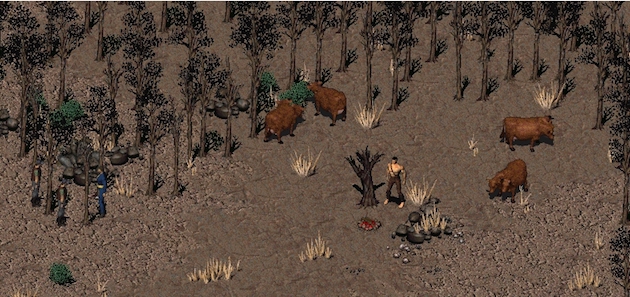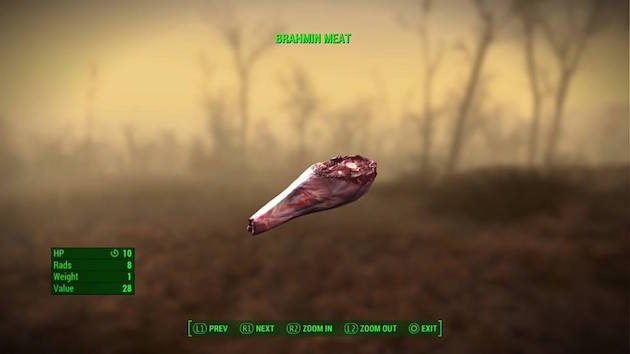The Science of Brahmin
Could Fallout's two-headed cattle actually exist?
The Fallout series is well known for a lot of things: a desolate radioactive wasteland, vaults, stylish blue and yellow jumpsuits, and of course, mutant creatures. Goodness gracious, does Fallout have mutant creatures. And of the series’ cadre of unnaturally-shaped fauna, none seem quite as important to human survival in the wasteland as the brahmin.
These mutated offshoots of regular bovines are everywhere, and are used for everything from physical labor to clothing to, of course, food. But just how plausible are brahmin? Would radiation actually cause a cow to grow a second head (along with a second heart and a total of eight stomachs)? Is it possible for cows to mutate so consistently that those features become default species traits? And assuming all of that is on the up and up, would it be safe for humans -- even humans that might have developed a tolerance to the increased levels of radiation on the surface -- to ingest them or even stand next to them? Well that’s what I aim to find out.

The Radiation
In order to figure out what kind of effect all of that radiation would have on regular cows, we first need to figure out how much radioactive fallout they were exposed to in the first place. A quick look at the Fallout Wiki reveals that the bombs used during what’s known in the game world as the Great War weren’t actually as powerful as those used in 1945. But while they weren’t as destructive, they released a significantly larger amount of radiation and did far more long-term damage to the ecosystem. In other words, the world’s superpowers threw out their nuclear bombs and stockpiled a bunch of neutron bombs instead.
This likely means that the iconic wasteland the series is known for wasn’t brought about by physical destruction, but rather by a steady poisoning of the environment. Seems like the perfect scenario for irradiating some cattle.
Taking a look at the effects of prolonged radioactive fallout on animals, it appears as though it would indeed be possible for whatever cattle that wasn’t either immediately killed by the explosions or out in the open within the blast radius of any of these bombs to survive, with the prolonged effects of radiation exposure not appearing until sometime later in their life. However, according to NCBI cows are also much more susceptible to radiation when it’s ingested - say, for example, if they were eating irradiated grass.
The Mutation
So how might long term exposure to less-than-lethal but still significant levels of radiation affect cows? According to a report from National Geographic detailing the return of wildlife to Chernobyl, it could actually create changes on a genetic level. Or it might not. It seems as though some animals are coping with the fallout just fine and others, well, aren’t. So whether or not all that radiation might cause cattle to mutate still isn’t a certainty - but it’s definitely a possibility.
There have been documented cases of cows that have been born with two heads due to genetic mutation, but it’s extremely rare. Of course, in a radioactive wasteland where most of the water and plants have absorbed lots of residual radiation, it doesn’t seem out of the question that the likelihood of such a mutation could increase. It seems far more likely that they’d develop genetic abnormalities like weakened immune systems or illnesses, but the possibility is still there.
The Day-to-Day

So while the odds aren’t exactly stacked in their favor, it does appear to be possible for a genetic subspecies like brahmin to develop as a result of long term (exceedingly long term) exposure to radiation. I’ll admit I’m actually kind of surprised by that. But what really surprises me is that humans could indeed use them much like regular cattle without much more risk than simply living in the wasteland. I know, right?
For starters, NCBI states that livestock is actually a pretty decent at naturally screening radiation. This means that there’s actually less of a risk of wasteland survivors absorbing too much radiation from eating brahmin meat. In fact, according to the CDC gamma radiation absorbed by brahmin via eating affected plants or drinking affected water could even result in irradiated meat that actually reduces the chances of bacterial transmission. In other words, brahmin meat could very well contain fewer harmful parasites and bacteria as the meat we eat today (which is still waiting on irradiation approval from the USDA).
What this means is, believe it or not, humans living in the wastelands of Fallout could live off of brahmin meat, use their leather for whatever they want to use leather for, and have them haul stuff around with no problem. Milk, on the other hand, is a different story. According to Fallout lore, brahmin milk is said to cure (or at least reduce the effects of) radiation sickness, but their milk would actually transfer far more radioactivity than their meat.
The Verdict
Truth be told, I expected that the existence of brahmin would be impossible outside of the Fallout universe. I was not expecting to find scientific evidence that would suggest otherwise. But there it is, plain as the flavor of a flat Nuke-a-Cola. While the chances are slim, it does indeed seem as though creatures like brahmin could have come into being after the events of Fallout’s Great War. Not only that, but they would’ve likely been safe to use in the same manner we use cows today. Well, with the exception of milk. Don’t drink the milk.
Rob Rich (@RobsteinOne) is just a guy who likes to play video games, then tell people about them. He's also a fan of the indie development scene.